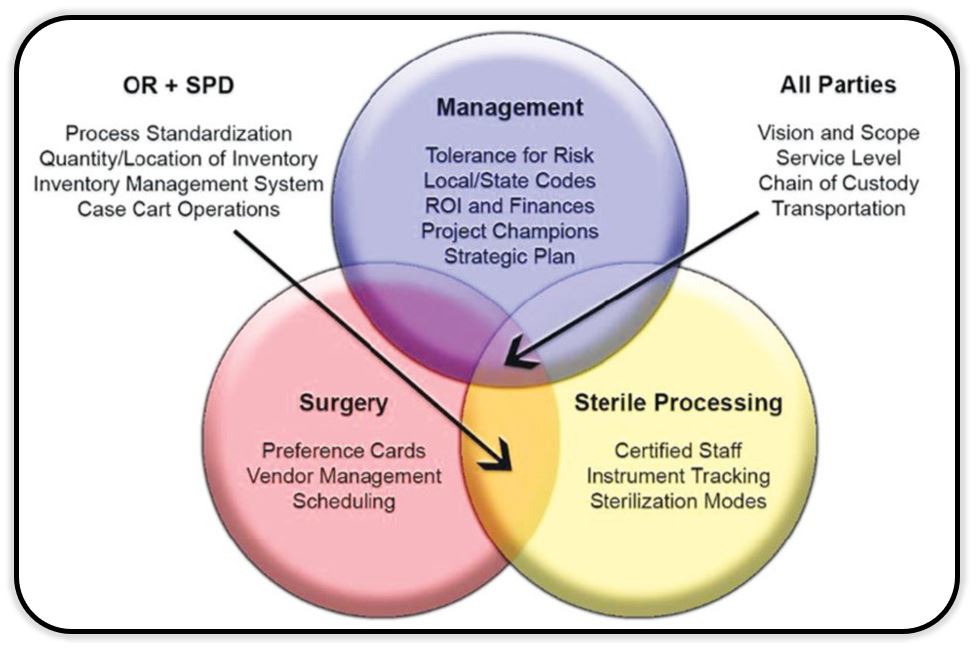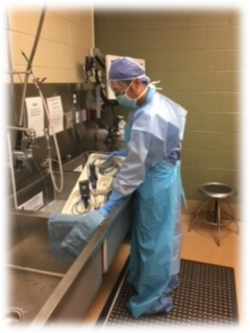Redefining the OR-SPD Relationship
Aug. 15 2019, surgicaladmin

Executive Summary:
Surgical Solutions hosted a focus group of ten Sterile Processing Department (SPD) managers (director level and above) in conjunction with this year’s national IAHCSMM conference in Anaheim, California. Among the issues and ideas shared by the focus group participants was the impact of surgeon familiarity with the Sterile Processing Department. Specifically, an opportunity exists to create a surgeon “SPD orientation” program to educate and elevate the crucial (and often misunderstood) function of the SPD, thus inspire surgeons to change behavior with respect to SPD.
_________________________________________________________________________________
On April 28, 2019, in Anaheim, California, Surgical Solutions conducted a focus group of 10 Sterile Processing Department (SPD) managers and administrators. The conversation centered around how SPD managers balance the multiple challenges that they face in order to ensure safe processing of surgical instrumentation and to keep OR turnaround time to a minimum. (see Figure 1 above)
Among the issues that affect SPD performance are:
• Equipment capacity and processing time
• Surgical instrument inventory
• Synchronizing demand and product availability
• Surgical instrument repair frequency and maintenance schedules
• Surgeons’ direct relationships with vendors
One SPD director shared, “When I look at my department, I look at it … from a process standpoint, as far as, do I have enough technology to support the day-to-day business? Do I have enough hands to do the work? What are my trays left per shift? I think that it’s important to have that external (resource) from infection control coming in to help me from a different perspective, of looking at how… where I might be missing the mark.”
The complexity of running a predictable and reliable SPD is not widely understood, even within the hospital management structure. While a crucial component of the efficient operation of surgical services, SPD also tends to be misunderstood and unseen by one of the key internal customers of the department: the surgeons. An article in Infection Control Today (Karen Lillis, SPD, OR Staff Play Equal Roles in Ensuring Case Turnover and Transition, 8/17/15) underscores this point when quoting a senior SPD manager, “Many doctors have no idea what the function of the sterile processing department are…In my 28 years in this industry, I’ve only seen three surgeons come and walk through SPD.”
Creating a surgeon SPD orientation program had not been undertaken by most of the focus group attendees prior to their participation in the Surgical Solutions focus group. Nor has the concept been widely documented in industry literature.
One of the focus group participants who has an SPD orientation program for physicians shared one surgeon’s comments:
“I have to be honest with you, I had no clue all of this ever went on. I’m really ashamed of myself, because I hadn’t engaged in it. I actually learned a lot from coming here.” (1)
Another SPD management professional was told by surgical residents who made a mandatory visit to the department:
“We didn’t know what goes on in surgical services.” (2)
The potential impact of a surgeon SPD orientation program was well summarized by this surgeon’s comments:
“I am so sorry…all these years I’ve been so wasteful. I honestly thought that you all dumped everything in a big machine, and just washed it. I never dreamed you were sitting here with a brush, washing every instrument. I am changing tomorrow.” (3)
Surgeon behavior change, along with the elevation of the crucial role of SPD in both patient safety and OR efficiency can be achieved with greater visibility, knowledge sharing and relationship building between SPD and the surgical team.
Further, SPD orientation can result in greater physician satisfaction. For example, at a hospital in New Mexico, SPD created a new surgeons’ onboarding process that included meeting with the SPD manager and discussing both SPD processes in general as well as each physician’s instrumentation needs.
Cheryl Barratt, RN, BS, MHA, principal and founder of Cheryl Barratt Associates, a leading perioperative consulting firm, shared her perspective, based on over 20 years of working with hospitals and ASCs across the country:
“Increasing the visibility of SPD by exposing surgeons to its process and workflow can serve to leverage the relationship between the department and one of its primary customer groups. While individual and group tours are ideal, a well-designed and scripted presentation to the OR Committee or the Department of Surgery might be considered as a means of reaching a larger audience. Coupled with the introduction of a quarterly surgeon satisfaction survey, SPD can begin to build a partnership with physicians to improve the quality of SPD products and services.”
While focus group members had very different approaches to managing their relationships with the OR team, there was consensus that surgeon involvement in the collaboration between the OR and SPD is crucial to patient safety.
Conclusion:
An SPD orientation program for surgeons represents a low cost/high impact opportunity to drive alignment between key drivers of OR safety and efficiency. Transparency, knowledge sharing, and relationship building are fundamental aspects of effective coordination and collaboration, and foster enhanced communication for future problem-solving. Creating and distributing communications that define and highlight the program and its objectives, along with engaging champions on the medical staff and in senior administration to endorse and encourage participation in the SPD orientation program can facilitate getting the program off the ground. Surgeons who are among the early participants and find the orientation helpful can then serve as “ambassadors” to promote participation among their peers.
References:
Figure 1. Derrick Bransby, Is Offsite Sterile Processing for Me? (Healthcare Purchasing News, 3/28/18)
(1) Surgical Solutions Focus Group, IASCHMM Conference, Anaheim California, 2019
(2) Ibid
(3) Ibid
surgicaladmin
Administrator
RELATED POST
-

Sterile Processing Department
The Role of the Sterile Processing Technician – The Unsung Hero of Perioperative Services
Read More



